| 24 June |
• yesterday • tomorrow |
| Solemnity of the Nativity of Saint John the Baptist |
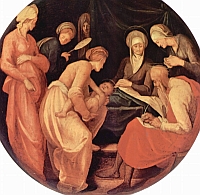
• Iohannes Baptista
• Joannes Baptista
• John the Baptizer
• John the Forerunner
• John, son of Zachary
• Juan Bautista
• Yochanan ben Zecharyah
• 24 June (birth)
• 29 August (death)
Cousin of Jesus Christ. Son of Zachary, a priest of the order of Abia whose job in the temple was to burn incense; and of Elizabeth, a descendent of Aaron. As Zachary was ministering in the Temple, an angel brought him news that Elizabeth would bear a child filled with the Holy Spirit from the moment of his birth. Zachary doubted and was struck dumb until John's birth.
Prophet. John began his ministry around age 27, wearing a leather belt and a tunic of camel hair, living off locusts and wild honey, and preaching a message of repentance to the people of Jerusalem. He converted many, and prepared the way for the coming of Jesus. He Baptized Christ, after which he stepped away and told his disciples to follow Jesus.
Imprisoned by King Herod. He died a victim of the vengeance of a jealous woman; he was beheaded, and his head brought to her on a platter. Saint Jerome says Herodias kept the head for a long time after, occasionally stabbing the tongue with his dagger because of what John had said in life.
• beheaded c.30 at Machaerus
• buried at Sebaste, Samaria
• relics in Saint Sylvester's church, Rome, Italy, and at Amiens, France
• against convulsions or spasms
• epileptics and against epilepsy
• against hail and hailstorms
• baptism
• bird dealers
• converts
• convulsive children
• cutters
• farriers
• French Canadians
• innkeepers
• lambs
• monastic life
• motorways
• printers
• tailors
• Jordan
• Puerto Rico
• Knights Hospitaller
• Knights of Malta
• 13 dioceses
• 70 cities
• cross in hand
• lamb
• severed head on a platter
• skin of an animal
• slender cross
• tall, thin cross
There is no doubt that blessed John suffered imprisonment and chains as a witness to our Redeemer, whose forerunner he was, and gave his life for him. His persecutor had demanded not that he should deny Christ, but only that he should keep silent about the truth. Nevertheless, he died for Christ. Does Christ not say: "I am the truth"? Therefore, because John shed his blood for the truth, he surely died for Christ. Through his birth, preaching and baptizing, he bore witness to the coming birth, preaching and baptism of Christ, and by his own suffering he showed that Christ also would suffer. Such was the quality and strength of the man who accepted the end of this present life by shedding his blood after the long imprisonment. He preached the freedom of heavenly peace, yet was thrown into irons by ungodly men. He was locked away in the darkness of prison, through he came bearing witness to the Light of life and deserved to be called a bright and shining lamp by that Light itself, which is Christ. To endure temporal agonies for the sake of the truth was not a heavy burden for such men as John; rather is was easily borne and even desirable, for he knew eternal joy would be his reward. Since death was ever at hand, such men considered it a blessing to embrace it and thus gain the reward of eternal life by acknowledging Christ's name. Hence the apostle Paul rightly says: "You have been granted the privilege not only to believe in Christ but also to suffer for his sake." He tells us why it is Christ's gift that his chosen ones should suffer for him: "The sufferings of this present time are not worthy to be compared with the glory that is to be revealed in us." - from a homily by Saint Bede the Venerable on the death of John the Baptist
Herodias harbored a grudge against him and wanted to kill him but was unable to do so. Herod feared John, knowing him to be a righteous and holy man, and kept him in custody. When he heard him speak he was very much perplexed, yet he liked to listen to him. She had an opportunity one day when Herod, on his birthday, gave a banquet for his courtiers, his military officers and the leading men of Galilee. Herodias's own daughter came in and performed a dance that delighted Herod and his guests. The king said to the girl, "Ask of me whatever you wish and I will grant it to you." She went out and said to her mother, "What shall I ask for?" She replied, "The head of John the Baptist." The girl hurried back to the king's presence and made her request, "I want you to give me at once on a platter the head of John the Baptist." The king was deeply distressed, but because of his oaths and the guests he did not wish to break his word to her. So he promptly dispatched an executioner with orders to bring back his head. He went off and beheaded him in the prison. He brought in the head on a platter and gave it to the girl. The girl in turn gave it to her mother. When his disciples heard about it, they came and took his body and laid it in a tomb. - Mark 6:19-29
https://catholicsaints.info/saint-john-the-baptist/

• Sister María Guadalupe
• Maria Guadalupe Garcia Zavala
• Mother Lupita
Daughter of Fortino García and Refugio Zavala de García; her father ran a religious goods store in front of the Basilica of Our Lady of Zapopan, and Maria grew up with a devotion to Our Lady. As a young woman she was engaged to marry but gave in to a call to religious life; with Father Cipriano Iñiguez she co-founded and served as the first mother superior of the Handmaids of Saint Margaret Mary and of the Poor. Worked as a nurse to the poor, and any time the Handmaids ran short of money, she would go begging for money to support their hospital. At great risk, she hid priests and the archbishop of Guadalajara from the anti-Catholic authorities during the Mexican Revolution.
27 April 1878 in Zapopan, Jalisco, Mexico
24 June 1963 in Guadalajara, Jalisco, Mexico of natural causes
Sunday 12 May 2013 in by Pope Francis in Rome, Italy
https://catholicsaints.info/saint-anastasia-guadalupe-garcia-zavala/
• Bartholomew of Durham
• Tostig, William
Descendant of Scandanavian immigrants to England. Because of the teasing he endured as a child, he changed his name from Tostig to William. A dissolute youth, he eventually left home to wander in Europe, possibly to avoid settling down in an arranged marriage. He experienced a conversion experience along with way, and emigrated for a while to his ancestral Norway where he worked as a missionary and ordained a priest.
William returned to England, and entered the Benedictine monastery at Durham, taking the name Bartholomew. He had a great devotion to Saint Cuthbert of Lindisfarne, received a vision of him, and eventually moved into Cuthbert's old cell on the island of Farne, spending 41 of his remaining 42 years there. The only break came when a dispute with the only other hermit in the hermitage caused him to pack up and return to Durham; his bishop eventually ordered him to act like he had good sense, and return to his cell.
12th century at Whitby, Northumbria, England as Tostig
1193 at Farne, England of natural causes
https://catholicsaints.info/saint-bartholomew-of-farne/
Alène
Daughter of a pagan chieftain in an area in modern Belgium. Secret convert to Christianity. One night she slipped out to hear Mass at the chapel in Vorst, Belgium. Her father found out, and ordered guards to follow her; they winessed her walk across the river Senne to reach the chapel. When the guards reported back to the king, he decided that the Christians had bewitched the girl, and ordered the guards to bring her back. She refused, fought with the guards, and during the struggle one of her arms was cut or torn off. Martyr. An angel appeared and took the arm to the chapel where it was placed before the altar. Alena's parents were shocked, but her fierce faith led them to examine Christianity, and they converted. The chapel with her relics became a popular place of pilgrimage.
early 7th century near Brussels Belgium
c.640 in Vorst, Belgium
• against eye trouble
• against toothache
• Vorst, Belgium
• princess healing a blind man
• princess with an angel
• princess with one arm off
• arm on an altar
• angel holding an arm
https://catholicsaints.info/saint-alena/
• Theodgar of Vendyssel
• Dieter, Dietger, Dioter, Teodgaro, Theodgardus, Thøger
Studied theology in England. Priest. Missionary to Norway. Courtier to King Olav Haraldsson II. Known to heal the sick by praying over them. Went into exile in Sweden with King Olav in 1028. Missionary to the area of Jutland, Denmark; he was making little headway until one morning a spring of fresh water began to flow from where he had slept the night before; the locals knew a miracle when they saw it, and began to take Theodgar’s teachings more seriously. Built the first church in the region.
Thuringia (in modern Germany)
• 24 June c.1065 in Jutland, Denmark of natural causes
• buried in Vestervig, Denmark
• relics transferred to the church of the Augustinian abbey in Vestervig, Denmark on 30 October 1117
Vestervig, Denmark
https://catholicsaints.info/blessed-theodgar-of-vestervig/
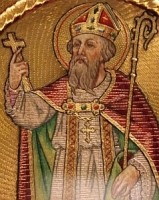
• Rombauld, Rombaut, Rombout, Romuold, Rumald, Rumbold, Rumoldus
• Apostle of Mechlin
Benedictine monk. Friend of Saint Gummarus. Evangalizing missionary bishop with Saint Willibrord of Echternach and Saint Libert in the area of modern Netherlands and Brabant, Belgium. Martyr, murdered by two men whose sinful ways he had denounced.
Some writers indicate that he was the son of a Scottish king, some that his brother was Saint Himelin, and some that he was bishop of Dublin, Ireland.
Ireland or England
• martyred c.775 near Mechelen, Flanders, Belgium
• relics in a golden shrine in the cathedral of Mechelen
Mechelen, Belgium
• bishop with a missionary's cross
• bearded man with a hoe lying under his feet
• murdered man near a coffer of money
https://catholicsaints.info/saint-rumold/
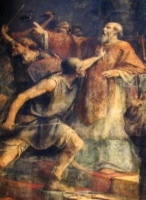
Gohard, Gunardo, Goardo
Bishop of Nantes, France Murdered by Norman raiders while celebrating Mass with a large group of monks and priests. Martyr.
8th century Angers, Neustria (in modern France)
• 24 June 843 in the Cathedral of Saint Peter, Nantes, Marche de Bretagne (in modern France)
• buried in the cemetery of the Collegiate Church of Saint Peter, Angers, France
• some relics enshrined in the cathedral in Nantes
1096 by Pope Urban II
https://catholicsaints.info/saint-gohardus/
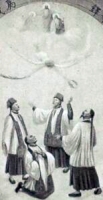
• Joseph Yuen
• Joseph Uen
• Josef Yuan Zaide
• Ruose
28 September as one of the Martyrs of China
Priest in the apostolic vicariate of Sichuan. One of the Martyrs of China.
c.1766 in Peng Co., Sichuan, China
strangled on 24 June 1817 in Chengdu, Sichuan, China
1 October 2000 by Pope John Paul II
https://catholicsaints.info/saint-iosephus-yuan-zaide/
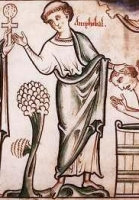
Cleric. Friend and co-worker with Saint Alban of Verulam. Marytred in the persecutions of Diocletian.
• c.304
• relics enshrined in Saint Alban's Abbey in 1178
https://catholicsaints.info/saint-amphibalus-of-verulam/
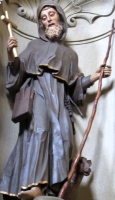
Ninth century Bohemian courtier who renounced his high position to become a hermit.
Bohemian
• of natural causes
• buried by Saint Ludmila
https://catholicsaints.info/saint-ivan-the-hermit/
Born to the nobility, the daughter of Duke Albert of Bavaria (in modern Germany). She became a Poor Clare nun in Munich, Germany.
15th century Bavaria (in modern Germany)
c.1473 of natural causes
https://catholicsaints.info/blessed-barbara-of-bavaria/
• Colman the Pilgrim
• Colmán, Colmanus
Student of Saint Finbar in Cork, Ireland. Evangelist in the area of Rosscarbery, East Carbery, County Cork, Munster, Ireland.
https://catholicsaints.info/saint-colman-oilithir-of-ross/
Heric
Benedictine monk. Headmaster of the monastic school at Saint-Germain d'Auxerre. Noted hagiographer.
at Hery, France
c.880 of natural causes
https://catholicsaints.info/blessed-henry-the-hagiographer/
Mercedarian priest. Missionary in area of modern Peru, Argentina and Paraguay. Martyred by Chiriguanos.
• shot with arrows in 1566
• body burned
https://catholicsaints.info/blessed-christopher-de-albarran/
Faustus was one of a group of 24 martyrs who died together in Rome, Italy, date unknown. His is the only name that has come down to us, and no other information about him has survived.
https://catholicsaints.info/saint-faustus-of-rome/
Agilbertus
Martyr.
in Creteil, Gaul (part of modern Paris, France) in the period of the the 5th to 7th century
https://catholicsaints.info/saint-agilbert-of-creteil/
Thiou
Benedictine monk. Abbot of Lobbes Abbey in Belgium. Bishop of Lobbes.
776 of natural causes
https://catholicsaints.info/saint-theodulphus-of-lobbes/
Agoardus
Martyr.
in Creteil, Gaul (part of modern Paris, France) in the period of the the 5th to 7th century
https://catholicsaints.info/saint-agoard-of-creteil/
Gerome, Germoe, Germanus Mac Guill
Sixth century Irish chieftain. Brother of Saint Breaca. Monk. Late in life he moved to Cornwall, England.
https://catholicsaints.info/saint-germoc/
Hermit near Tuy, Spain.
9th century Spanish Galatia
relics enshrined in the Dominican church at Tuy, Spain
https://catholicsaints.info/saint-john-of-tuy/
Born to the Frankish nobility. Married. Bishop of Autun, Gaul (in modern France).
c.375
https://catholicsaints.info/saint-simplicio-of-autun/
Benedictine monk. Abbot of Kremsmünster in Austria in 1050.
https://catholicsaints.info/saint-erembert-i-of-kremsmunster/
Martyr.
on the Via Salaria Antica, Rome, Italy
https://catholicsaints.info/saint-john-of-rome-24-june/
Martyr.
on the Via Salaria Antica, Rome, Italy
https://catholicsaints.info/saint-festus-of-rome/
Seven Christian brothers who were soldiers in the imperial Roman army. They were kicked out of the military, exiled and eventually martyred in the persecutions of Maximian. We know little more about them than their names - Cyriacus, Firminus, Firmus, Longinus, Pharnacius, Heros and Orentius.
c.311 at assorted locations around the Black Sea
https://catholicsaints.info/martyrs-of-satala/
• Madonna della Navicella
CatholicSaints.Info Portable Edition